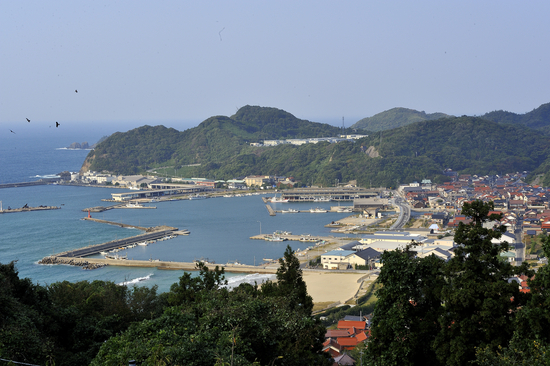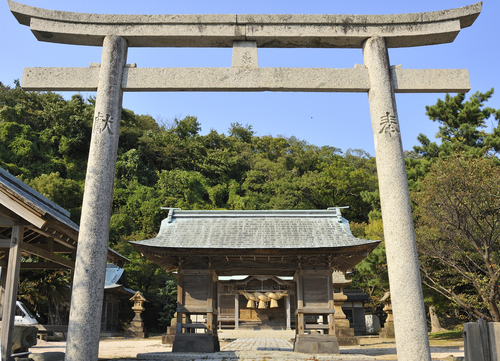Etomo-ura
| Bay Name | Etomo-ura |
|---|---|
| Shrine Name | Kitano Tenjin (Former) Etomo-jinja (current) |
| Deity |
Iwasakahiko-no-mikoto |
| Location |
Matsue-shi Kashima-cho 374 (Aza Kitakumi ) |
Esumi ura Kitano Tenjin
Miyou ya koko ni Kitano no kami no masu
Shirushi ni tatsuru matsu to ume to wa

The 'Kitano Tenjin' in 'Esumi-ura' mentioned in the poem remains unsolved so far. The only Tenjin that comes to mind in relation to the locality around Etomo is the Ko-ura tenjin. Certainly there is mention of Kitano Tenjin in the 1710 ' 42 Bay Pilgrims Verses', along with the reference to 'Kitano no kami' (the god of Kitano). However, looking more closely at the content of the poem/song, we see part of a line which could be interpreted as observing "How strange there should be the Kitano kami here..." suggesting that the verse writer, too was in some doubt about the Kitano Tenjin.
Again, in the Unyoshi, written about the same time in 1717, the article on Esumi only mentions the shrines ' Etomo no umibe no yashiro' , 'Umibe no yashiro', Ebisumiya, Suijin and Koujin. There is nothing written about a 'Kitano' Tenjin. Further, Kanezaki Zenbei from Kumano town who catalogued his travels around the 42 bay pilgrimage circuit in 1863 wrote about praying at Esumi ura shrines with a mention only of a 'Etomogami'.
One train of thought is that there was a 'Kitano Tenjin' up to the Houei Era (1704-1711), but then the name was changed during the Kyouhou Period (1716-1736) in line with the 'Etomo jinja' listed in the Fudoki. There doesn't, however seem to be much of a connection between the Fudoki shrine and the Tenjin faith.
Another possibility is that the two shrines were merged, however there is no trace of this currently in Esumi ura. Whichever way you look at it, the shrine visited by Kanezaki Zenbei in Esumi ura is the old shrine Etomo jinja seen in the Fudoki as 'Etomo Umibe ' shrine.
When Omuro Washiro made his pilgrimage in 1866, he noted praying at 'Esumi Daimyoujin' and received the stamp directly from the shrine priest. His notes from that area only mention 'Etomo' , 'Ebisu' and Etomo Umibe' shrines. Again, there is no record of Kitano Tenjin.

Etomo Shrine is located near the harbor, a few hundred meters after crossing Sata River from the direction of Ko-ura. The town of Etomo has a bank, post office, market, Ichibata Bus stop, and a dining area. Heading south will take you to the Kashima Branch of the Matsue City Office. To the north of the city office, on the new road leading to Kataku Hachimangu, is the Shimane Nuclear Power plant. Its Unit 1 plant was opened in 1974 and Unit 3 has recently been constructed. Apart from the plant itself, there is also a Nuclear Power Hall where visitors can learn more about nuclear power and energy.
The Tondo festival of Etomo follows the same pattern as that of Ko-ura with the Toshitoku-gami portable shrine carried through the town with a model of that year's Zodiac sign.
Also like Ko-ura, Etomo holds an annual 'open sea festival' (Dragon god festival) on April 21st, the day after Ko-ura. In the afternoon, a small boat containing Ryujin is taken to the harbor and then onto the Prayer Hall of Etomo Shrine where it is blessed in a ceremony and finally returned to the harbor to set sail in the evening. In addition, there is a 'Bay safety dance' event on November 9th where four Elementary school 4th and 5th graders dance accompanied by the singing of some 6th graders.
While Etomo is a large harbor, according to the owner of the dining area, they are unfortunately, unable to serve locally produced fish dishes due to the significant decline over the years in fishermen.
Etomo is also the birthplace of the scholar and sometime translator, Masuda Wataru, who studied under the esteemed writer and essayist, Lu Xun after meeting him in Shanghai in 1931. Masuda can be found listed in the credits of the book 'Selected Works of Lu Xun'. Masuda and his family are said to have donated several lanterns placed around the grounds near the Prayer Hall of Kataku Hachimangu shrine. A display mentioning the works of Masuda, as well as his connection to Lu Xun can be seen in the 'Kashima Historical Folk Customs Archives Office' located south of Sada Jinja (shrine).
| Bay Name | Etomo-ura |
|---|---|
| Shrine Name | Kitano Tenjin (Former) Etomo-jinja (current) |
| Deity |
Iwasakahiko-no-mikoto |
| Location |
Matsue-shi Kashima-cho 374 (Aza Kitakumi ) |
Esumi ura Kitano Tenjin
Miyou ya koko ni Kitano no kami no masu
Shirushi ni tatsuru matsu to ume to wa
The 'Kitano Tenjin' in 'Esumi-ura' mentioned in the poem remains unsolved so far. The only Tenjin that comes to mind in relation to the locality around Etomo is the Ko-ura tenjin. Certainly there is mention of Kitano Tenjin in the 1710 ' 42 Bay Pilgrims Verses', along with the reference to 'Kitano no kami' (the god of Kitano). However, looking more closely at the content of the poem/song, we see part of a line which could be interpreted as observing "How strange there should be the Kitano kami here..." suggesting that the verse writer, too was in some doubt about the Kitano Tenjin.
Again, in the Unyoshi, written about the same time in 1717, the article on Esumi only mentions the shrines ' Etomo no umibe no yashiro' , 'Umibe no yashiro', Ebisumiya, Suijin and Koujin. There is nothing written about a 'Kitano' Tenjin. Further, Kanezaki Zenbei from Kumano town who catalogued his travels around the 42 bay pilgrimage circuit in 1863 wrote about praying at Esumi ura shrines with a mention only of a 'Etomogami'.
One train of thought is that there was a 'Kitano Tenjin' up to the Houei Era (1704-1711), but then the name was changed during the Kyouhou Period (1716-1736) in line with the 'Etomo jinja' listed in the Fudoki. There doesn't, however seem to be much of a connection between the Fudoki shrine and the Tenjin faith.
Another possibility is that the two shrines were merged, however there is no trace of this currently in Esumi ura. Whichever way you look at it, the shrine visited by Kanezaki Zenbei in Esumi ura is the old shrine Etomo jinja seen in the Fudoki as 'Etomo Umibe ' shrine.
When Omuro Washiro made his pilgrimage in 1866, he noted praying at 'Esumi Daimyoujin' and received the stamp directly from the shrine priest. His notes from that area only mention 'Etomo' , 'Ebisu' and Etomo Umibe' shrines. Again, there is no record of Kitano Tenjin.
Etomo Shrine is located near the harbor, a few hundred meters after crossing Sata River from the direction of Ko-ura. The town of Etomo has a bank, post office, market, Ichibata Bus stop, and a dining area. Heading south will take you to the Kashima Branch of the Matsue City Office. To the north of the city office, on the new road leading to Kataku Hachimangu, is the Shimane Nuclear Power plant. Its Unit 1 plant was opened in 1974 and Unit 3 has recently been constructed. Apart from the plant itself, there is also a Nuclear Power Hall where visitors can learn more about nuclear power and energy.
The Tondo festival of Etomo follows the same pattern as that of Ko-ura with the Toshitoku-gami portable shrine carried through the town with a model of that year's Zodiac sign.
Also like Ko-ura, Etomo holds an annual 'open sea festival' (Dragon god festival) on April 21st, the day after Ko-ura. In the afternoon, a small boat containing Ryujin is taken to the harbor and then onto the Prayer Hall of Etomo Shrine where it is blessed in a ceremony and finally returned to the harbor to set sail in the evening. In addition, there is a 'Bay safety dance' event on November 9th where four Elementary school 4th and 5th graders dance accompanied by the singing of some 6th graders.
While Etomo is a large harbor, according to the owner of the dining area, they are unfortunately, unable to serve locally produced fish dishes due to the significant decline over the years in fishermen.
Etomo is also the birthplace of the scholar and sometime translator, Masuda Wataru, who studied under the esteemed writer and essayist, Lu Xun after meeting him in Shanghai in 1931. Masuda can be found listed in the credits of the book 'Selected Works of Lu Xun'. Masuda and his family are said to have donated several lanterns placed around the grounds near the Prayer Hall of Kataku Hachimangu shrine. A display mentioning the works of Masuda, as well as his connection to Lu Xun can be seen in the 'Kashima Historical Folk Customs Archives Office' located south of Sada Jinja (shrine).






